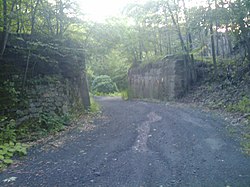Ashley Planes | |
 Abutments from the Ashley Planes in 2009 | |
| Location | Off Pennsylvania Route 309 in Fairview Township and Hanover Township, Pennsylvania |
|---|---|
| Coordinates | 41°11′26″N 75°54′37″W / 41.19056°N 75.91028°W |
| Area | 160.3 acres (64.9 ha) |
| Built | 1837, 1860s, 1909 |
| Built by | Douglas, Edwin A.; LC&N. |
| NRHP reference No. | 80003562[1] |
| Added to NRHP | January 25, 1980 |
Ashley Planes was a historic freight cable railroad situated along three separately powered inclined plane sections located between Ashley, Pennsylvania at the foot, and via the Solomon cutting the yard in Mountain Top over 1,000 feet (300 m) above and initially built between 1837 and 1838 by Lehigh Coal & Navigation Company's subsidiary Lehigh and Susquehanna Railroad (L&S).
One result of the 1837 updates of omnibus transportation bills called the Main Line of Public Works (1824), the legislation was undertaken with an eye to enhance and better connect eastern settlement's business interests with newer mid-western territories rapidly undergoing population explosions in the Pre–Civil War era. But those manufactories needed a source of heat, and Coal Region of Northeastern Pennsylvania was barely connected to eastern markets except by pack mule, or only through long and arduous routes down the Susquehanna River then over land to Philadelphia.
The Ashley Planes job was to join two railroad sections at either elevation and bridge over the drainage divide between the Susquehanna Valley and that of the Lehigh and Delaware Valleys. It was purpose-built to join the freight capacity of two canals, the Pennsylvania Canal System, locally the West Susquehanna Division at Pittston, and the Lehigh Canal and via the Susquehanna River, connect to other transportation infrastructure between Philadelphia and Pittsburgh. The Planes role, specified in the legislation, was to connect the seaports of the Delaware River with the new interior settlements of the near-midwest along the tributary rivers of the vast Mississippi River drainage basin. It was designed during the mid-canal era as part of an overall strategic schema to lift heavy freight eastwards out of the Susquehanna Valley in suburban Wilkes-Barre into the eastside descents, which gravity aided to the canal head and thence using cheap practical water transport ended feeding much needed coal into all the big coastal cities of the Eastern United States accessible via the Delaware Valley, and to transoceanic destinations.
This connecting road was an important link that connected Pittsburgh, the Ohio River, and the midwest to the eastern coastal cities via Pennsylvania's canal system and later, other railroads, the shortest path at the time. In the late 1830s, the current mobile steam locomotives were still in the early stages of development and relatively weak and underpowered compared to those available in the 1850s. As a result of this lack of viable rail transport, political planners, and businessmen regarded canals and water transport via barges over natural water features as the only pragmatic means of shipping bulk goods.
The Planes were built in 1837 to 1838 by the Lehigh Coal & Navigation Company (LC&N) in Luzerne County, Pennsylvania. They were built concurrently with rail lines and an extension of the Lehigh Canal. The Planes were connected by rail to the Pennsylvania Canal sending goods and passengers west and via Mountain Top by rail to White Haven. The Mountain Top to White Haven route also sent Northern Coal Region anthracite down the newly extended Lehigh Canal. The incline railroads were located at Fairview Township and Hanover Township. Before and after loading, coal hoppers would be staged from the Central Railroad of New Jersey's (CNJ) Mountain Top Yard, which was leased from LH&S from the 1870s in nearby Mountain Top, Pennsylvania. The three railroads were built in 1837, the 1860s, and 1909, and feature a stationary power source using cable winding and winching and cars traveling down as a counterweight to a car being lifted on parallel tracks.
It was added to the National Register of Historic Places in 1980.[1]


